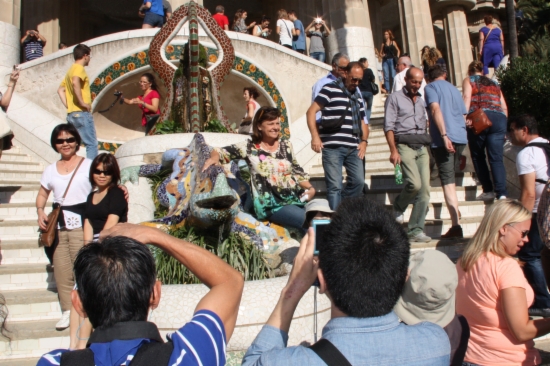Barcelona to invest €4.5 million in renovating Park Güell
Barcelona City Council will allocate almost €4.5 million for the maintenance, restoration and enhancement of the architectural heritage of Antoni Gaudí’s famous Park Güell and its surroundings. This investment comes from the fee charged to enter the park, but also partly from the city tourist tax, Barcelona Councillor for Architecture Daniel Mòdol stated. Since October 2013, tourists visiting the spot have had to pay an entrance fee. The Councillor of Gràcia District in Barcelona, Eloi Badia, explained that the remodelling aims at controlling the influx of visitors and recovering the daily life of the neighbourhood as well as the cultural and commercial activity of the area. According to Badia, many neighbours believe that they have to pay to enter the enclosure, but locals are not charged. “We want neighbours to understand that they can access [the park] for free, and we want to recover the cultural and daily activities”, he stressed.

Barcelona (CNA) .- Barcelona City Council will allocate nearly €4.5 million for the maintenance and restoration of Park Güell’s architectural heritage and its surroundings so as to better manage the influx of visitors to the garden, the only one in the city recognised as a World Heritage Site by UNESCO. Barcelona Councillor for Architecture, Daniel Mòdol, stated that the project is funded in part “thanks to revenue from park ticket booths and the tourist tax”. Since October 2013, people visiting Antoni Gaudí’s monuments in Park Güell have to pay an entrance fee. The Councillor of Gràcia District in Barcelona, Eloi Badia, explained that the remodelling seeks to recover the daily life of the neighbourhood as well as the cultural and commercial activity of the area. “We want neighbours to understand that they can access [the park] for free, and we want to recover the cultural and daily activities”, he said. According to the data, after the implementation of the regulation in 2013, the Monumental Zone of Park Güell, the one for which people have to pay, has seen a decrease in visitors, from approximately nine million in 2012 to 2.7 in 2015.
Specifically, the work to be done will affect the ‘Sala Hipòstila’, a chamber in the enclosure composed by 86 columns. Its restoration will cost €1.2 million and includes plans, among other undertakings, to restore its inner domes and to remodel and open the ‘Font de la Sarva’, a fountain hitherto closed to the public. Construction work will last 16 months.
In addition, €944,000 will be spent to repair the waterproofing and the system for collecting water from the Plaça de la Natura (Square of Nature), which in turn acts as the roof of the Hipòstila Sala. This will be done through a new drainage system that will be installed in six months.
Regarding the work outside the enclosure, the City Council will revamp the stairs of Pompeu Fabra Avenue, at a cost of nearly €173,000. It will also set up the Glòria slope, well known for its mechanical stairs. These parts of the restoration, which in some cases include the burial of surfaces currently visible, will require about three months of work.
The project also wants to improve access to the entrance and the revival of this part of the park as a recreational space. To this end the City Council will spent €390,000. It is expected that the work will end in four months. As part of this increased accessibility, according to Badia the municipal Government is looking for ways to facilitate entry for Barcelona residents bearing in mind that this is an area “saturated” and that it requires combining local public free access with the existence of a hosting capacity. Access to the Monumental Zone of Park Güell is limited to 400 tickets every half hour.
Barcelona’s Park Güell entrance fee
Since October 2013, people visiting Antoni Gaudí’s monuments in Park Güell have had to pay an entrance fee. A general entrance ticket costs 7 euros. Barcelona City Council approved this measure three years ago, aiming to better control the number of tourists visiting Gaudí’s monuments and to obtain revenue to pay for security and maintenance.
Park Güell is one of the most popular spots on Barcelona’s tourist circuit and before the measure it was very crowded and neighbours were complaining about these large crowds. After implementation of the regulation in 2013, the park has seen a decrease in visitors, from approximately nine million in 2012 to 2.7 in 2015.